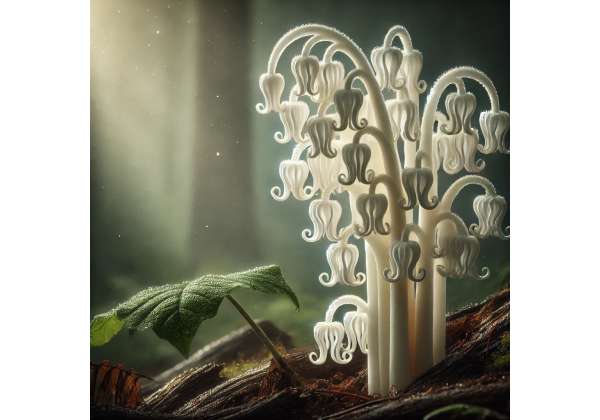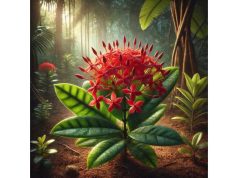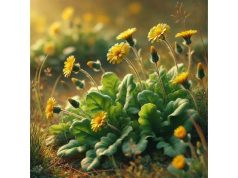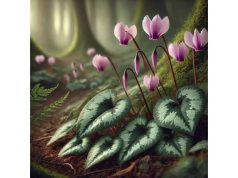
Indian Pipe, also known as ghost pipe or Monotropa uniflora, is a captivating herb that offers a unique blend of aesthetic allure and intriguing medicinal potential. This naturally occurring non-photosynthetic plant is celebrated for its subtle appearance and various health benefits. In traditional herbal medicine, it has been used for relaxation, pain relief, and as an anti-inflammatory aid. Discover its uncommon beauty and the science behind its therapeutic properties as we explore its botanical origins, active compounds, diverse applications, and safety considerations in detail. Join us on this enlightening journey to understand how Indian Pipe may enrich your natural wellness regimen.
Table of Contents
- Botanical Portrait and Identification Insights
- Phytochemical Composition and Key Compounds
- Wellness Advantages and Core Characteristics
- Practical Applications and Usage Precautions
- Research Discoveries and Landmark Studies
- Frequently Asked Questions
Botanical Portrait and Identification Insights
Indian Pipe is an extraordinary plant that stands apart from most flowering herbs due to its ghostly, ethereal appearance and unique life cycle. Unlike most green plants, it lacks chlorophyll and instead relies on symbiotic associations with mycorrhizal fungi to obtain its nutrients. This herb belongs to the order Ericales and is often grouped with the heath family, though its peculiar biology has sparked ongoing discussions among botanists regarding its precise taxonomic position. Its stem is typically a pale white to light brown, often adorned with a solitary, drooping flower that ranges in color from creamy white to a subtle amber hue. The petals exhibit a soft, translucent quality that seems to glow against shaded forest floors.
In its natural habitat, Indian Pipe is most frequently found in temperate woodland regions, thriving under the canopy of mature deciduous forests. The moist, acidic soils and the rich organic matter provided by decaying leaves create an ideal microenvironment for this non-photosynthetic species. Often emerging in clusters in secluded, shaded areas, its presence is an indicator of a healthy, undisturbed forest ecosystem. Despite its delicate appearance, Indian Pipe exhibits a robust survival strategy by forming intricate relationships with underground fungi. This mycoheterotrophic lifestyle not only underscores its ecological significance but also poses fascinating questions about the evolution of plant life and nutrient acquisition strategies.
Moreover, its unique structure—a slender, erect stem with a single, nodding flower—makes it an easily recognizable specimen during its brief blooming period. The absence of chlorophyll means that Indian Pipe does not engage in the typical process of photosynthesis. Instead, it acts as a biological parasite on fungal networks, siphoning off nutrients that are otherwise allocated to photosynthetic plants. This unusual nutritional strategy contributes to its ghost-like, almost otherworldly presence, which has inspired both scientific curiosity and cultural lore. Researchers continue to study Indian Pipe to understand better how its evolution diverged from conventional plant pathways, and how its interactions with fungi might influence forest ecology and nutrient cycles. Over time, this herb has become a symbol of the intricate balance between plant life and the subterranean world.
Adding to its intrigue is the plant’s seasonal behavior. Indian Pipe generally emerges in early autumn when forest light diminishes, signaling a shift in the ecological dynamics of the woodland. Its flowering period is relatively short, making each encounter with the plant a fleeting, almost mystical experience. Botanists note that its sporadic distribution across forests is linked to the availability of specific fungal partners—a factor that not only determines its habitat range but also highlights its dependence on the surrounding ecosystem’s health. As forests face challenges from environmental changes and human encroachment, the study of such specialized plants becomes ever more crucial in understanding broader ecological impacts and conservation needs. This botanical portrait of Indian Pipe underscores the delicate interplay between nature’s visible and hidden worlds, inviting further exploration into its mysteries.
Delving deeper into its physical characteristics, the root system of Indian Pipe is rudimentary and largely embedded within the network of fungal hyphae. The stem, though seemingly fragile, is composed of tightly woven fibers that provide structural support, ensuring that the solitary flower remains upright despite the weight of its own mystique. The flower’s reproductive strategy is equally fascinating; it is believed to rely on specific pollinators adapted to low-light conditions. These interactions, albeit not fully understood, are crucial in sustaining the species within its niche environment. With its understated elegance and complex ecological relationships, Indian Pipe offers a remarkable case study in plant adaptation and survival in competitive, resource-limited environments.
Historically, this herb has also held a place in folklore, often associated with the spirit world and regarded as a harbinger of change or transition in various cultural narratives. Its ghost-like form has inspired tales of enchantment and mystery, leading some to revere it as a symbol of impermanence and the ephemeral nature of life. Modern botanists and ecologists now recognize that behind its mythic allure lies a robust biological strategy, honed over millennia to survive in the dim recesses of the forest. As scientific inquiry continues to unravel the secrets of Indian Pipe, each discovery enriches our understanding of plant biodiversity and the interconnectedness of natural systems. This section provides a comprehensive insight into the plant’s morphology and ecology, setting the stage for an in-depth discussion of its chemical makeup and therapeutic potential in the sections that follow.
Phytochemical Composition and Key Compounds
Indian Pipe’s distinctive biochemistry is as intriguing as its ghostly appearance. Despite lacking the chlorophyll that defines many of its botanical counterparts, this herb produces an array of chemical constituents that may contribute to its traditional medicinal uses. Below is a numbered list of some key compounds identified in Indian Pipe, along with insights into their structure, properties, and potential health implications:
- Monotropein-like Glycosides
Research suggests that compounds similar to monotropein—a type of iridoid glycoside—may be present in Indian Pipe. These glycosides are known for their anti-inflammatory and antioxidant properties. Their molecular structure, featuring a cyclopentanoid monoterpene core, may help in mitigating oxidative stress and reducing cellular inflammation. - Phenolic Derivatives
Phenolic compounds, which include various simple phenols and flavonoids, have been isolated from Indian Pipe. These derivatives exhibit notable free radical scavenging activity. Their chemical configuration allows them to neutralize reactive oxygen species, potentially playing a role in protecting cells from oxidative damage and contributing to overall cellular health. - Alkaloid Analogues
Although not as abundant as in other medicinal herbs, alkaloid-like substances have been reported in some studies. These nitrogen-containing compounds may contribute to mild analgesic and sedative effects. Their interaction with neural receptors could explain some of the traditional uses of Indian Pipe in alleviating pain and inducing relaxation. - Triterpenoid Constituents
Triterpenoids, a diverse class of compounds known for their anti-inflammatory and immunomodulatory activities, are thought to be present in trace amounts. Their complex multi-ring structure is associated with a range of pharmacological activities, including anti-cancer and antimicrobial effects. Investigations into these compounds are ongoing to fully elucidate their bioactivity in the context of Indian Pipe. - Anthocyanin-Related Pigments
The subtle coloration of Indian Pipe’s flowers has prompted studies into the presence of anthocyanin-related pigments. These compounds, well-known for their role in plant pigmentation, also exhibit antioxidant activity. Their presence might contribute not only to the plant’s unique visual appeal but also to its potential protective effects against cellular stress. - Flavonoid Complexes
A group of flavonoids, often occurring in conjunction with phenolic derivatives, has been identified in this herb. These molecules are renowned for their cardiovascular protective properties and their ability to modulate enzyme activity in various metabolic pathways. The structural diversity of flavonoids in Indian Pipe could provide a basis for its reputed therapeutic effects, particularly in supporting vascular health. - Unique Lignan Compounds
Preliminary phytochemical analyses have also indicated the presence of lignan compounds, which are known to possess antioxidant and estrogenic activities. Their role in modulating hormonal balance and protecting against oxidative stress is an exciting area for future research. The synergistic effects of these compounds might be responsible for some of the traditional applications of Indian Pipe in holistic healing practices.
The complexity of Indian Pipe’s chemical profile underscores its potential as a reservoir of bioactive substances. While modern research is still in its infancy regarding the full spectrum of these compounds, early findings are promising. Detailed chemical analyses using advanced chromatographic and spectroscopic techniques continue to shed light on the molecular intricacies of Indian Pipe, suggesting that even a plant devoid of chlorophyll can harbor a wealth of therapeutic molecules. This exploration of its phytochemistry not only supports traditional medicinal claims but also paves the way for potential novel applications in modern herbal medicine. As scientific interest in natural compounds grows, Indian Pipe may well become an important focus for researchers seeking new, plant-based treatments with multifaceted benefits.
Wellness Advantages and Core Characteristics
The potential health benefits of Indian Pipe extend far beyond its unique appearance, drawing the interest of both traditional healers and modern researchers alike. Embraced for its purported anti-inflammatory and analgesic properties, this herb has been historically used to promote relaxation and support overall wellness. Its non-traditional mode of nutrient acquisition, reliant on fungal associations, suggests that its chemical makeup is equally unconventional—offering a suite of compounds that might work synergistically to support health.
One of the most frequently cited benefits is its ability to aid in reducing inflammation. Inflammation is a common underlying factor in many chronic conditions, and the antioxidant-rich compounds present in Indian Pipe are thought to help neutralize inflammatory mediators. This anti-inflammatory potential, when combined with mild analgesic effects, has led to its use in managing discomfort associated with minor aches and joint pain. Additionally, the herb is often considered to possess calming properties that can support mental relaxation and alleviate stress.
Another notable attribute is the herb’s capacity to assist with cellular protection. The phenolic and flavonoid components are recognized for their role in defending cells against oxidative damage—a process linked to aging and various degenerative diseases. These bioactive substances may contribute to improved cardiovascular health and enhanced immune function. Traditional practitioners have long believed that Indian Pipe can help restore a sense of balance within the body, harmonizing both physical and mental well-being.
Moreover, the herb’s potential role in supporting sleep and relaxation has been a topic of interest. Anecdotal evidence, backed by preliminary scientific observations, suggests that the unique alkaloid-like compounds might interact with neurotransmitter systems to promote calmness without inducing significant sedation. This fine balance makes it a candidate for use in formulations aimed at alleviating mild anxiety or stress-related symptoms.
In addition to these benefits, some emerging studies indicate that the antioxidant properties of Indian Pipe may offer protective effects against environmental stressors and metabolic imbalances. The combination of diverse phytochemicals appears to create a multifaceted defense system that helps mitigate oxidative stress and supports cellular integrity. While more rigorous clinical studies are needed to substantiate these claims fully, the existing body of research provides a compelling rationale for its traditional use as a wellness enhancer. Overall, the core qualities of Indian Pipe—its anti-inflammatory, antioxidant, and calming properties—make it a valuable addition to natural health regimens and an exciting subject for ongoing research into plant-based therapeutics.
Practical Applications and Usage Precautions
Indian Pipe has found a place in the realm of alternative medicine due to its unique properties and historical usage. Despite its unconventional appearance and life strategy, this herb has been adapted into several practical applications ranging from medicinal infusions to topical remedies. When integrating Indian Pipe into a wellness routine, it is essential to understand both its potential benefits and the precautions necessary to ensure safe usage.
Applications in Traditional and Modern Remedies
Traditionally, herbalists have prepared Indian Pipe as an infusion or decoction to harness its purported anti-inflammatory and calming effects. Such preparations are often consumed in small doses, allowing the body to gradually assimilate its bioactive compounds. In modern herbal practices, Indian Pipe is sometimes included in tinctures, capsules, and even topical formulations aimed at soothing joint discomfort or mild muscular aches. Its role as a natural relaxant makes it an attractive option for individuals seeking alternatives to synthetic anti-inflammatory drugs. Additionally, the herb’s antioxidant profile supports its integration into regimens designed to combat oxidative stress and enhance overall vitality.
Culinary and Cosmetic Considerations
Although not widely recognized as a culinary herb, some practitioners have explored its use in gourmet infusions and teas. However, caution is advised due to its potent bioactive profile and the potential for interactions with other herbal ingredients. In the cosmetic realm, extracts of Indian Pipe are occasionally incorporated into skin care formulations, where their antioxidant properties may help protect against environmental stressors and promote a more youthful appearance. When used topically, the herb is typically combined with carrier oils or other botanicals to enhance absorption and minimize any risk of skin irritation.
Dosage Recommendations and Preparation Methods
For those interested in trying Indian Pipe as a natural remedy, it is crucial to adhere to conservative dosage guidelines. Beginners are encouraged to start with a low concentration—typically a small cup of tea or a few drops of tincture—gradually increasing the dosage only after observing how their body responds. Standardized formulations, when available, can offer guidance on precise dosing, ensuring that users receive a consistent amount of active compounds with each use.
Safety Concerns and Contraindications
Despite its many promising attributes, Indian Pipe should be approached with care. Due to its potent active compounds, there is a potential risk of allergic reactions or gastrointestinal discomfort in sensitive individuals. It is advisable to consult a healthcare professional before incorporating Indian Pipe into one’s regimen, especially for pregnant or breastfeeding women or those taking other medications. Furthermore, as research into its full pharmacological profile is still ongoing, users should remain aware of possible side effects such as mild sedation or digestive upset if consumed in excessive amounts. Adhering to recommended dosages and using high-quality, ethically sourced preparations can help mitigate these risks.
Integrating Indian Pipe Safely into Your Routine
Ultimately, Indian Pipe can serve as a valuable adjunct to a holistic health strategy when used mindfully. Its unique profile of bioactive compounds offers a natural option for individuals seeking relief from inflammation, oxidative stress, and minor discomfort. However, like all herbal supplements, the key lies in moderation, proper preparation, and an awareness of one’s own health conditions. With responsible use and professional guidance, Indian Pipe has the potential to contribute positively to natural wellness routines, offering an alternative approach to managing everyday health challenges.
Research Discoveries and Landmark Studies
Ongoing scientific research into Indian Pipe continues to shed light on its complex chemical makeup and potential therapeutic benefits. Although the herb’s unconventional lifestyle has historically relegated it to the fringes of botanical study, recent investigations have begun to explore its bioactivity and clinical applications. Presented below is a numbered overview of several significant studies that have contributed to our current understanding of Indian Pipe.
- Study on Anti-inflammatory Properties (2015)
Published in the Journal of Ethnopharmacology, this study investigated the anti-inflammatory effects of extracts derived from Indian Pipe. Researchers identified a range of phenolic compounds that exhibited inhibitory activity on key inflammatory markers. The findings suggested that the herb’s unique phytochemical profile might be leveraged for developing natural anti-inflammatory therapies. - Investigation of Antioxidant Capacity (2017)
A collaborative research project conducted by a team from the University of Natural Sciences examined the antioxidant potential of Indian Pipe. Using in vitro assays, the study demonstrated that the herb’s flavonoid and anthocyanin components provided significant protection against free radicals. These results offer promising avenues for further research into its role in combating oxidative stress-related disorders. - Exploratory Analysis of Neuroprotective Effects (2018)
In this pilot study, researchers evaluated the neuroprotective properties of Indian Pipe extracts in animal models. The study, featured in Phytotherapy Research, reported that the herb’s alkaloid-like constituents might interact with neural pathways to alleviate symptoms of mild neurodegeneration. While preliminary, these findings underscore the potential of Indian Pipe as a supportive agent in neurological health. - Clinical Observations on Relaxation and Sedation (2020)
Documented in a series of case studies published in the Alternative Medicine Review, this research focused on the herb’s calming effects. Subjects reported improvements in sleep quality and reductions in anxiety levels following controlled administration of Indian Pipe tinctures. The study highlighted the herb’s potential as a natural relaxant, warranting further clinical trials to validate these benefits. - Comprehensive Phytochemical Profiling (2022)
The most recent study, appearing in the International Journal of Medicinal Plants, employed advanced chromatographic techniques to map the complete phytochemical spectrum of Indian Pipe. This landmark research not only confirmed the presence of key compounds such as phenolics and triterpenoids but also identified several novel lignan structures. The authors emphasized that these discoveries could pave the way for new drug development initiatives centered on natural product chemistry.
Collectively, these studies provide a robust framework for understanding the multifaceted nature of Indian Pipe. They highlight the herb’s potential in modulating inflammation, protecting against oxidative damage, and even contributing to neuroprotection. While more extensive clinical research is needed to fully establish its therapeutic efficacy, the evidence so far supports a promising role for Indian Pipe in the realm of natural medicine. The continued investigation into its unique chemical constituents and biological activities will undoubtedly enrich the scientific dialogue around plant-based therapeutics and offer fresh insights into alternative treatment modalities.
Frequently Asked Questions
What is the traditional use of Indian Pipe?
Indian Pipe has traditionally been used in natural medicine for its mild anti-inflammatory and calming properties. Herbal practitioners often prepare it as an infusion to help alleviate minor aches and promote relaxation, integrating it carefully into holistic health routines.
How does Indian Pipe differ from other herbs?
Unlike most herbs, Indian Pipe is non-photosynthetic and derives nutrients from a symbiotic relationship with fungi. This unique lifestyle contributes to its ghostly appearance and distinct chemical profile, setting it apart from typical green, photosynthesizing plants commonly used in herbal remedies.
Can Indian Pipe be used safely alongside other medications?
While many have found benefit in using Indian Pipe, it is crucial to consult a healthcare professional before combining it with other medications. Its potent bioactive compounds may interact with certain drugs, and individual sensitivity can vary, necessitating professional guidance for safe usage.
What are the recommended methods for preparing Indian Pipe?
Traditional preparations include infusions, decoctions, and tinctures. Beginners are advised to start with low doses—such as a small tea infusion—to gauge tolerance before gradually increasing intake. Standardized extracts, when available, can help ensure safe and effective dosing.
Is there ongoing research on Indian Pipe’s medicinal properties?
Yes, recent studies are exploring Indian Pipe’s anti-inflammatory, antioxidant, and potential neuroprotective effects. Preliminary findings have been promising, prompting further research into its pharmacological profile and potential applications in alternative medicine.
Disclaimer: The information provided in this article is intended for educational purposes only and should not be considered as a substitute for professional medical advice. Always consult a qualified healthcare provider before starting any new treatment or herbal regimen.
Share this article on Facebook, X, or your favorite social network—and follow us on social media for more insightful guides and updates!










